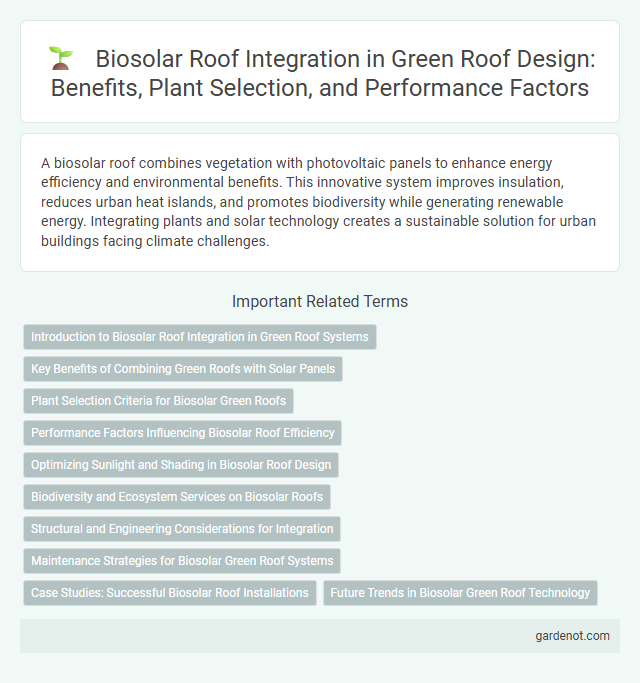A biosolar roof combines vegetation with photovoltaic panels to enhance energy efficiency and environmental benefits. This innovative system improves insulation, reduces urban heat islands, and promotes biodiversity while generating renewable energy. Integrating plants and solar technology creates a sustainable solution for urban buildings facing climate challenges.
Introduction to Biosolar Roof Integration in Green Roof Systems
Biosolar roof integration combines photovoltaic solar panels with green roof vegetation to enhance energy efficiency and urban sustainability. This hybrid system improves building insulation, reduces heat island effects, and generates renewable energy simultaneously. Innovative materials and design strategies enable seamless incorporation of solar technology without compromising the ecological benefits of traditional green roofs.
Key Benefits of Combining Green Roofs with Solar Panels
Biosolar roofs integrate photovoltaic solar panels with vegetated green roofs, enhancing energy efficiency while promoting urban biodiversity. This synergy reduces rooftop temperatures, boosting solar panel performance by up to 15% and decreasing building cooling costs significantly. The combined system also improves stormwater management, mitigates urban heat islands, and extends roof lifespan by protecting underlying materials from UV exposure and extreme weather.
Plant Selection Criteria for Biosolar Green Roofs
Plant selection for biosolar green roofs hinges on species that maximize photosynthetic efficiency while tolerating solar panel shading and rooftop microclimates. Drought-resistant, low-maintenance plants with shallow root systems, such as sedums and native grasses, optimize water retention and soil stability under solar arrays. Selecting biodiversity-supportive flora enhances ecosystem services, promoting pollinator habitats and improving energy performance by reducing ambient roof temperatures.
Performance Factors Influencing Biosolar Roof Efficiency
Performance factors influencing biosolar roof efficiency include optimal sunlight exposure, plant species selection, and integrated photovoltaic panel quality. Proper irrigation and drainage systems significantly impact plant health and energy production, enhancing overall sustainability. Thermal regulation achieved through vegetation cover reduces cooling loads, maximizing the biosolar roof's eco-friendly potential.
Optimizing Sunlight and Shading in Biosolar Roof Design
Biosolar roof design strategically integrates photovoltaic panels with vegetation to optimize sunlight capture and natural shading, enhancing energy efficiency and thermal regulation. By carefully positioning solar panels to maximize exposure while allowing plant growth in shaded areas, this design reduces heat island effects and improves building insulation. Advanced modeling tools assess solar angles and plant species to ensure dynamic balance between energy generation and environmental benefits.
Biodiversity and Ecosystem Services on Biosolar Roofs
Biosolar roofs enhance biodiversity by providing habitats for pollinators, birds, and beneficial insects, contributing to urban ecosystem resilience. These roofs integrate photovoltaic panels with diverse vegetation, promoting microhabitats that support ecological networks and improve ecosystem services such as air purification and temperature regulation. The synergy between green infrastructure and solar energy on biosolar roofs fosters sustainable urban environments and supports biodiversity conservation efforts.
Structural and Engineering Considerations for Integration
Biosolar roofs require careful structural analysis to support the combined weight of vegetation, solar panels, and roofing materials, ensuring load capacity meets local building codes. Engineering solutions include reinforced roofing membranes and drainage systems to manage water retention and prevent structural damage. Integration demands collaboration between structural engineers and environmental specialists to optimize energy efficiency while maintaining roof durability.
Maintenance Strategies for Biosolar Green Roof Systems
Biosolar green roof systems require targeted maintenance strategies to optimize both vegetation health and solar panel efficiency, including regular inspection of plant cover to prevent shading and debris accumulation on photovoltaic surfaces. Effective irrigation management ensures balanced moisture levels that support plant growth without compromising electrical components, while periodic cleaning of solar panels maximizes energy capture. Integrating sensor technology allows real-time monitoring of temperature, humidity, and panel performance, facilitating proactive maintenance and extending system lifespan.
Case Studies: Successful Biosolar Roof Installations
Case studies of successful biosolar roof installations highlight the synergy between photovoltaic technology and green roofing, showcasing enhanced energy efficiency and environmental benefits. Notable projects such as the Copenhagen International School and the headquarters of Bosch demonstrate significant reductions in urban heat island effect and increased renewable energy generation. These installations exemplify how integrated biosolar systems contribute to sustainable urban development and carbon footprint reduction.
Future Trends in Biosolar Green Roof Technology
Biosolar roof technology integrates photovoltaic cells with vegetative green roofs, enhancing energy efficiency and urban biodiversity simultaneously. Future trends emphasize advanced materials for higher solar panel efficiency, adaptive plant species for improved microclimate regulation, and smart irrigation systems powered by AI. Continuous research aims to optimize the symbiotic relationship between solar energy generation and sustainable vegetation growth on urban rooftops.
Biosolar roof Infographic

 gardenot.com
gardenot.com